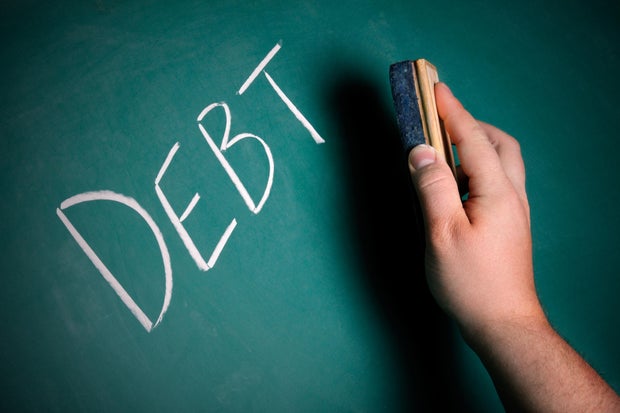
Is credit card debt forgiveness still worth it with interest rates paused?
1. August 2025
Getty Images
The Federal Reserve made headlines again this week when it decided to keep its benchmark interest rate unchanged at a range of 4.25% to 4.5% during its July meeting. The decision to hold rates steady is a continuation of the central bank’s wait-and-see strategy, which it has implemented for 2025 as it monitors how inflation trends and policy decisions impact the costs of everything from housing to gasoline and groceries.
This news comes as a blow to potential borrowers, who have, in turn, been facing higher-than-average rates on personal loans, mortgages and most other borrowing products over the last few years. So, while the latest pause may not make borrowing more expensive, it won’t help ease the costs, either. And, it also raises the question of what strategies now make sense to tackle your high-rate credit card balances.
If you’re carrying a hefty amount of credit card debt, for example, you may be wondering whether an aggressive approach, like credit card debt forgiveness, still makes sense in today’s unusual rate environment. So, is debt forgiveness worth it, or is another debt relief approach a better bet currently? Let’s take a closer look.
Find out what debt relief strategies you can use to get out of debt now.
Is credit card debt forgiveness still worth it with interest rates paused?
Despite the Federal Reserve’s decision to pause interest rate hikes again, credit card debt forgiveness is still a potentially worthwhile option for many borrowers. After all, the Fed’s extended rate pause hasn’t translated into meaningful relief on credit card interest rates thus far, despite rates remaining paused for many months in a row.
Right now, the average credit card APR is still hovering near 22%, which is just slightly under the latest record high. So, if you have a balance from month to month at that rate (or higher), the interest charges can quickly compound, making it difficult, if not impossible, to get ahead.
And, the reality is that even if the Fed eventually cuts rates later this year or in early 2026, credit card APRs are unlikely to fall substantially. Credit card issuers tend to be slow to pass along savings from rate cuts, and because card rates are influenced by more than just the federal funds rate, including lender risk models, consumer credit profiles and economic uncertainty, any drop that does occur is likely to be marginal at best.
Meanwhile, credit card balances are continuing to balloon. The average consumer now owes about $8,000 in credit card debt, and total credit card debt in the U.S. has surpassed $1.18 trillion, a record high. And, with the cost of essentials still elevated due to inflation, many households are relying on credit cards to fill budget gaps, which only deepens the debt trap.
This is where debt forgiveness can play a vital role. Debt forgiveness is one of the few strategies that can actually reduce the principal you owe, not just the interest. If you’re already behind on payments or at risk of falling behind, creditors may be more willing to negotiate a lump-sum payoff that’s lower than the total balance. While your credit score will take a hit in the short term, that impact may be worth it if you can erase thousands of dollars in debt and avoid more drastic options like bankruptcy.
Plus, debt forgiveness can be especially smart to pursue right now because waiting for rates to fall isn’t a guaranteed solution. When the Fed does finally cut rates, it could take years for borrowers to truly feel the effects. In contrast, debt forgiveness offers a more immediate path to relief, typically resolving enrolled debts within two to four years, depending on your financial situation and the program terms.
Ultimately, though, the value of debt forgiveness comes down to your financial position. If you’re juggling high balances, struggling with minimum payments and have exhausted other options like balance transfers or debt consolidation loans, debt forgiveness may be your most realistic path forward.
Learn how to get started on a path to debt forgiveness today.
When does credit card debt forgiveness make the most sense?
If you’re thinking about pursuing credit card debt forgiveness, now may be an ideal time to act if you fall into one or more of these categories:
- You’re behind on payments or nearing default: If you’ve missed payments or are at risk of defaulting, creditors may be more open to negotiating a reduced payoff amount.
- Your credit score has already taken a hit: Settling your debt can hurt your credit in the short term, but if your score is already damaged by missed payments or maxed-out cards, it may be a worthwhile trade-off to eliminate debt faster and start rebuilding.
- You can’t keep up with minimum payments: If your monthly payments barely cover interest and your debt is growing, waiting for rates to fall likely won’t solve the problem. Debt forgiveness could offer faster relief.
- You need a clean slate to rebuild financially: Having a portion of your debt forgiven can provide more than just financial relief; it can also give you breathing room to rebuild your finances, start saving and reduce financial stress.
The bottom line
While the Federal Reserve’s decision to pause rate cuts might be disappointing for some borrowers, it shouldn’t derail your debt forgiveness plans if you’re struggling with credit card debt. Today’s high credit card rates probably aren’t going anywhere anytime soon, regardless of what happens with Fed policy.
So, if you’re carrying significant credit card debt and finding it difficult to make progress on your balances, this debt relief strategy remains a viable option. The math is simple: Reducing your total debt burden through settlement is often more effective than hoping for modest interest rate reductions that may never materialize.
